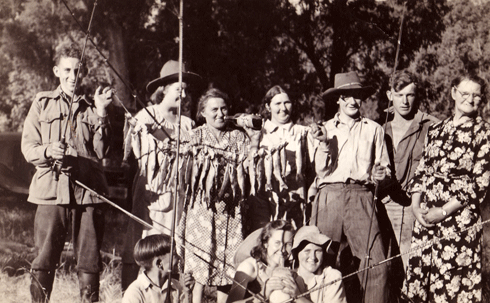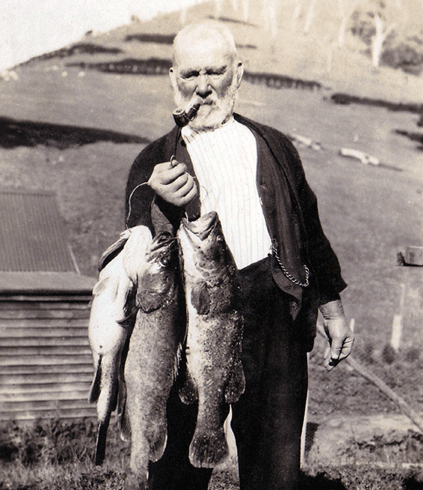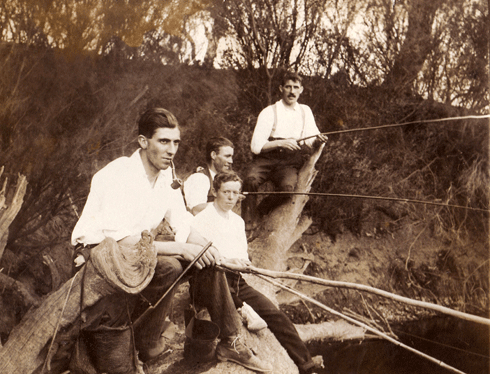
|
Published: 1 October 2012
When the rivers ran wild: fishing tales from another world
Will Trueman, the author of the book True Tales of the Trout Cod, is intrigued by the strong social and cultural connections that Australians have to the Murray–Darling Basin’s native fish and waterways. The recollections he has documented point to a very different river system than the one we see today.
I discovered native fish in my childhood, mostly through family stories of past days when they had been common in north-east Victoria. By the 1960s my ‘patch’ in Victoria had changed, and native fish had largely been replaced by redfin perch, trout, and later European carp.
I then discovered the Seven Creeks (near Euroa in northern Victoria’s Goulburn-Broken catchment), which at the time contained healthy populations of native fish whose habitat had been spared from invasion by exotic fish. Waterfall barriers had prevented upstream access by redfin perch and carp and, although the waters had been regularly stocked with trout, the lack of suitable spawning habitat prevented the establishment of salmonids (trout).
The Seven Creeks later came into prominence as containing the last population of trout cod in Victoria, an enigmatic fish whose existence was only officially acknowledged as recently as 1972.
In 2006, I started a project to investigate what historical records and knowledge was available about trout cod. The project resulted in a comprehensive historical record of larger native fish in the Murray–Darling Basin (MDB) and their origins from the Macquarie catchment southwards. It has now been published as a book, True Tales of the Trout Cod, along with nine river and fish history booklets focusing on different areas of the MDB, a website and 19 ‘conversations’ with me shared through YouTube.
In answering the original question about the trout cod’s distribution, I made some other discoveries. The first is the inherent generosity of rural Australians who helped me by sharing their memories and photographs to construct the history. It is the connection to the land that makes rural Australians key players in our efforts to repair the environment and achieve the aims of the Native Fish Strategy.
At the project’s completion, I had interviewed nearly 140 people aged from 20 to 95 years, and had collected 400 photographs as far back as 1862. These people were saddened by the changes they had seen in the rivers and native fish.
It makes me so sad to see what’s happening down there, it makes me cry. These days, as I drift back through the years and think about my fishing in the Murrumbidgee, I can only say it may not have been heaven, but it was next door.
Noel Denson, Tumut, 2008

|
|
The Suffield family with a catch of trout taken from the King River near Cheshunt, Victoria, c1945. Credit: Max Suffield/ARRC
|
My second discovery was how much the riverine environments of the Basin have changed in less than two centuries.
I read the original writings of the first Europeans to record the pristine environments in each catchment. The descriptions were Kakadu-like:
Swans, in the hot months, abounded on the river; for they came in from the dry lagoons to the water ... Ducks of all kinds, teal and native companions (a great large crane), geese and swans abounded in flocks ... Along the river you would see the great high-piled stick nests of the swans, so built on branches that they could rise or fall with the river.
Lawrence Struilby, Mitta Mitta, 1842
As I travelled from catchment to catchment and recalled what they had been once like, it was difficult to reconcile the past with the present. Although people will have an interest in True Tales to learn what fish were once present in what streams, it is the information that provides comparisons between past and present-day environments that is most powerful.
For fish and wildlife, the changes to original populations in some cases have been so slow and subtle as to be almost unnoticed, in others sudden and dramatic. There is something of a parallel in what we each experience by looking at our image in a mirror on a day to day basis and then at the photograph of years ago. Each day we appear exactly as we did yesterday; however the photograph shows the accumulated change.
Jack Rhodes, Corowa, 1999
[Fortunately,] in my life time, I have seen significant progress. Landcare groups are restoring riparian environments, environmental flows are being provided to waterways, snags are being returned to rivers, and barriers to fish migration removed. Trout cod are making a comeback, with several reproducing populations becoming established from restocking. These are all positive signs.
True Tales is a valuable educational tool to increase awareness of current environmental issues and the need for action. By collating the historical descriptions of the fish and rivers of the MDB, a window into a lost world has been created.
We can’t change the past; we can only create the future. Achieving the goals of the Native Fish Strategy can only take place through the recognition of river managers, anglers and the community as to what the past was like and how the MDB can be improved in the future.
It’s no use blaming what happened; in a lot of cases it was sheer ignorance, not knowing a new country. When you look at the rivers and see what’s happened, well, they’re not the same. I think we need to fix some of the rivers for the natives. One man can’t make a difference, but a lot of men can.
Frank Moore, Mansfield, 2006
This article first appeared in RipRap, the magazine of the Australian River Restoration Centre (ARRC), which worked with the Murray-Darling Basin Authority to publish True Tales project information online. A related book published by CSIRO Publishing is Flood Country: An Environmental History of the Murray-Darling Basin.





